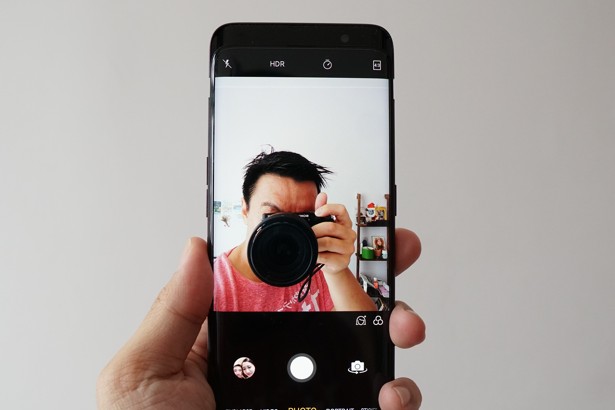
Review | World’s most bezel-less phone, Oppo Find X, is a truly daring device and good performer, but may have gone overboard
The Find X smartphone from Chinese tech firm Oppo takes the pop-up camera concept seen in the Vivo Nex to the extreme, resulting in a stunning-looking device that also performs well. But will its mechanics stand the test of time?
Just a week after Vivo launched its notch-less Nex phone with a pop-up camera, Oppo (owned by the same parent company, BBK Electronics) unveiled its own device: the Find X, which follows a similar concept but takes it to the extreme. Let’s take a look.
Design and hardware
The Oppo Find X, with its 93.8 per cent screen-to-body ratio, is even more bezel-less than the Nex, at 91.2 per cent. This slight difference is noticeable only when you place the two phones side-by-side; the Find X’s chin is maybe 2mm slimmer, but in the cutthroat smartphone market where millimetres matters, that makes it the most bezel-less phone ever made.
Vivo Nex smartphone review: a Mandarin-speaking assistant, no bezels and no notch
Just like the Nex, the Find X uses an elevating module to house its front-facing selfie camera, thus eliminating the need for a notch (that tiny black cut-out on top of the edge-to-edge screen pioneered by the iPhone X). But while the Nex only pops-up a small module, the entire top of the Find X rises, revealing a chunk of forehead that houses not just the front-facing camera but also an additional infrared camera for facial scanning and, on the back, dual “main” cameras.
But – as with the Vivo Nex – having a mechanical moving part in a phone could backfire, no matter how well-built. A camera module that moves up and down over and over has a higher chance of malfunction than a camera that does not move.
That concern is at least tripled with the Find X. The phone has no fingerprint reader at all; facial scanning is the only form of biometric security available, which means every single time a user unlocks the Find X, its top will rise up. That is also the case every single time both the front and back cameras are used.

On the Nex, only frequent selfie takers would have to worry about the mechanism wearing down. On the Find X? Users are going to be popping that thing up and down at least 80 times a day, and that’s a conservative estimate. For what it’s worth, Oppo claims that it has tested the Find X’s mechanism 300,000 times with no issue.

This bold design does make the Find X stunning to look at. When its top is recessed, the phone has virtually no holes or openings, and its curved glass body and gradient paint job make it resemble a piece of marble or gemstone.

The uninterrupted 6.4-inch OLED display is sourced from Samsung, and it even sports the dual curves of the South Korean giant’s Galaxy flagships. The front of the Find X does look and feel very similar to the Samsung Galaxy S9+, just without bezels.
Oppo phones tend to run on mid-range processors, but the company knew that with a device this visually stunning, it would be a waste to give it anything but the top specs. The Find X, therefore, comes with a speedy Snapdragon 845 processor with 8GB of RAM.
Software and features
Most of this year’s Android phones offer facial recognition as a way to unlock them, but almost all employ a simplistic 2D scan that uses the selfie camera. These are nowhere near as secure as the iPhone X’s true 3D facial scanning system. It was expected that Xiaomi’s yet-to-be released Mi 8 Explorer Edition would be the first Android device with a true 3D face scanning system, but the Find X beat it to the market.

From my testing, the Find X’s facial scanning is a legitimate 3D system. I couldn’t trick it with life-size photos or videos of my face, and the phone displays an Animoji rip-off that successfully mimicked my facial movements.
The Find X will almost certainly be the most daring handset released this year
The time it takes for the phone’s top to slide up, scan my face and unlock is about half a second. This is impressive considering how much action is going on, but it’s ultimately slower than a fingerprint reader.
Despite the Nex and Find X both employing similar concepts, they took different approaches to replacing the other components usually found in a phone’s top bezel. The Nex found a way to embed its proximity sensor underneath the display and eliminated the earpiece all together in favour of a vibrating sound technology similar to bone conduction. The Find X, meanwhile, keeps the earpiece – it’s just impossibly small and is almost hidden – but ditches the proximity sensor entirely, instead using an AI-backed software developed by Silicon Valley start-up Qeexo that intelligently guesses when the user’s ear and face are pressed against the display.

In terms of software the Find X runs ColorOS, Oppo’s Android skin, over Android 8.1. ColorOS is not as intrusive as Vivo’s FunTouch, or garish as Huawei’s EMUI, but it is still a very Chinese Android skin, meaning it borrows one too many ideas from iOS – no app tray, system-wide search menu – and gets in the way of Android too much.
Out of the box, most people will have a hard time getting lockscreen widgets for audio apps, and some push notifications will be delayed due to aggressive battery management. I managed to fix these problems eventually, but it took 20 minutes of diving deep into the settings and making changes.
Performance and battery life
The Find X’s performance has been a pleasant surprise. Despite the high specs, I kept expecting the pop-up mechanism to freeze or lag on me during heavy use – but so far, nothing. And despite the cameras being mounted on a thin sliding mechanism, photo and video quality are very good.
I did notice the phone’s shutter speed is a tad slower than other top Androids. I took shots of passing cars with the Find X and Huawei P20 Pro and they were almost always more blurry in the Find X’s images. But when taking photos of still objects, I have no complaints. Colour accuracy, dynamic range and balance are all on point.

With a 3,730 mAh battery and software that has aggressive optimisation, battery life will be no issue for most.
Conclusion
As a smartphone geek, I love the Find X for its truly unique design and out-of-the-box thinking. It will almost certainly be the most daring handset released this year.
OnePlus 6 review: similar to top iPhone or Samsung but half the price
But recommending it to the average consumer is another story. The Find X’s need to physically elevate its top panel every single time a user unlocks the phone, take a photo, or use Chinese e-payment apps just leaves too much room for mishaps. No case will be able to cover the top of the phone either.
Specifications
Dimensions: 156.7 x 74.2 x 9.4mm
Weight: 186g
Display: 6.4-inch 1,080 x 2,340 curved OLED panel
Battery: 3,730 mAh
OS version reviewed: ColorOS 5.1 over Android 8.1
Processor: Snapdragon 845
Cameras: Pop-up 16MP f/12.0 sensor with a 20MP secondary telephoto lens; 25MP front-facing pop-up camera
Memory: 8GB of RAM; 128GB ROM
Colours: Red, blue
Price: 4,999 yuan (US$745)

